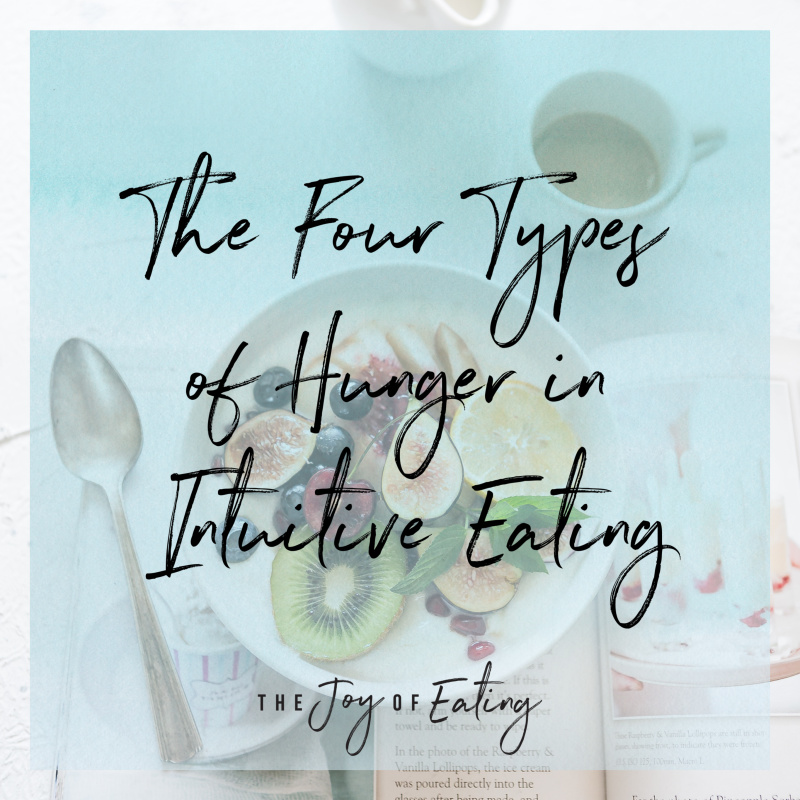

Us non-diet dietitians talk a lot about hunger in intuitive eating. There’s a reason honor your hunger is the second principle of intuitive eating – it’s incredibly important! As I remind my clients, honoring your hunger and fueling your body appropriately creates space for you to engage with the other principles of intuitive eating.
That said, there’s a lot more to honoring your hunger than simply eating when you feel a rumble in your stomach. Did you know there are other types of hunger outside of physical hunger? In intuitive eating there are four types of hunger, all of which are important to be able identify and have tools to navigate.
Since it’s a frequent topic of discussion in session, I’m writing this blog post as a resource for my clients, and hopefully to help others that are reading it understand what’s fueling the desire for food, and in making decisions around food that feel good!
The Four Types of Hunger in Intuitive Eating
Physical Hunger
Physical hunger stems from a need for energy from food. Just like when our bladder stretches, it signals a need to pee, or when our mouth feels dry, it signals a need to hydrate, when we feel the physical signs of hunger, it means we need food. We normally think of hunger as an empty or gnawing sensation in the stomach, but you can also experience signs of hunger outside the stomach. Sometimes physical hunger can present as fatigue, anxiety, headaches, shakiness, or simply thinking more about food. The only way to take care of physical hunger is to eat! Contrary to what Cosmo magazine taught you in 1998, chewing gum or drinking water isn’t helpful for making physical hunger go away – it might suppress hunger for a short period, but like a beach ball being pushed underwater, it will pop back up wildly. I’ll also add that there’s no need to suppress physical hunger. How cool is it that your body can signal when your energy needs are low? Like an energy gage on your car, hunger cues are a helpful tool for making sure you’ve got the fuel you need.
Taste Hunger
Taste hunger occurs when you have a taste for a specific food. It may present outside of physical hunger or alongside physical hunger. Basically, taste hunger is when a food just sounds good! An example of pure taste hunger might be when you’ve just eaten a satisfying meal at a restaurant and are feeling quite satisfied, but then you see the dessert menu and feel taste hungry when you see something appealing on it. Remember, taste hunger is valid hunger! You are allowed to eat when you’re not hungry, just because something looks or sounds good. However, when you know more tasty foods are coming, you might not feel an urgency to fulfill every brief moment of taste hunger you experience.
Emotional Hunger
Emotional hunger is when you have an unmet emotional need that presents itself with a desire to eat food. This is what is often referred to as “emotional eating,” a phrase I kinda sorta hate, but people know what I’m talking about when I say it. Essentially it is using food as a tool to cope with, soothe/comfort, numb/distract, or amplify an emotion – either a positive or negative emotion. Emotional eating isn’t off limits in intuitive eating. As I discuss in this blog post on emotional eating, food can be one way to soothe, but it’s helpful to have other options AND to give yourself permission to eat emotionally, as that creates space for the food to actually do it’s job and help you feel better.
Sometimes it can be hard to distinguish physical and emotional hunger. Some ways to tell if it’s an emotional hunger is when it comes on quickly in conjunction with an intense emotion. You might have also recently eaten, or feel the need for comfort, security or distraction more so than a need for energy. Below is a graphic I use with clients to help distinguish emotional and physical hunger. I will add that under physical hunger I note that the desire for food is less specific, and I think that is certainly the case when it’s mild physical hunger, but I’ve found both for myself and for many clients that when you are intensely hunger, often times your hunger can get REALLY specific.





:max_bytes(150000):strip_icc()/20241101-SEA-AppleFritters-RobbyLozano_Hero1-12-d5be39677bbe4b85aa133e72fb587983.jpg?w=238&resize=238,178&ssl=1)





